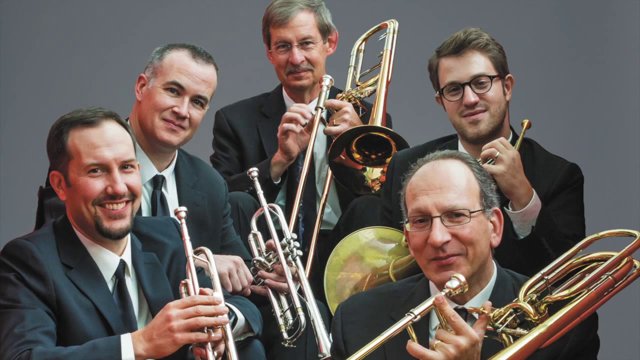 |
| Center City Brass Quintet |
For today's class, we listened to Laudes (1972) by Jan Bach and Four Outings for Brass (1974) by André Previn. There are several similarities between these two landmark works; each is a four-movement work for brass quintet, written in the early 1970's by American composers although Previn was born in Germany and emigrated to the US when he was
nine, and both recordings we listened to were made by the Center City Brass Quintet.
We just lost composer Jan Bach on October 30th, 2020. Laudes is one of the most important works for brass quintet of the 20th century. His writing is imaginative, challenging, and utilizes the full range and color of all of the instruments. The four movements of Laudes are:
I. Reveille
II. Scherzo
III. Cantilena
IV. Volta
Program Notes by Jan Bach:
"Laudes (loud-ays), as its name may imply, is a Twentieth- Century tribute to the great brass tower music of the Italian Renaissance. Its title has several different associations: I(louds) was the sunrise service of the Roman Catholic Church. Laude (loud- ee) were Italian hymns of praise and devotion which flourished from the 13th through the 19th centuries. And the title is also a musical pun: somewhere in each movement is a loud concert A! The work was written in late 1971 at the request of the Chicago Brass Quintet, which premiered the piece at Chicago's Museum of Contemporary Art on January 21, 1972.
The work is cast in four contrasting movements. Reveille moves from dark to bright colors, alternating sections of relative inactivity with sections of extreme brilliance and energy. Its title was chosen after the fact, because of the music's suggestion of a sunrise. Scherzo is cast in three-part form, its quick outer sections consisting principally of a single melodic line produced by rapid entrances and exits of the five instruments playing their "open" (valveless) tones con sordino, the middle section consisting of chromatic scale segments in both principal and supporting material. Cantilena gives each instrument an opportunity to dominate one of several solo sections which alternate with weightier sections of all five instruments, each section cadencing in the same d minor/c minor polychord. Volta, a lewd dance (the couples actually embraced each other!) of Provencal origin, is in this instance a quick movement of violent dynamic and textural contrasts. After an exhausted breakdown of the instrumental forces near the end of this movement, the suite concludes with a coda based on a slow section of the first movement; out of this coda emerges a gradually rising and quickening line which brings the work to a brilliant close.
In 1974 this work received international attention when it was chosen as the best new brass quintet submitted to the First International Brass Institute in Montreux, Switzerland. Since that time, Laudes has been performed countless times throughout the world, largely through the efforts of the New York Brass Quintet, which performed it on two European and several American tours, recorded it on Crystal records, and published it through their Mentor Music house. Laudes opened the Kennedy Library in Boston, and was danced to by the Hubbard Street Dancers on the streets of New York. It is one of a very few works by living contemporary composers existing simultaneously in four different recordings, three of which on CD and recorded since 1990. In 1983 a poll of International Trumpet Guild members selected it (along with works by Dahl, Schuller, and Etler) as one of the four most significant brass quintets ever written."
Four Outings for Brass has a more accessible and popular-influenced sound to it, which is not surprising as Previn composed for films and performed and recorded jazz, but it is also very challenging to perform. The four movements are:
I. Moderato, with energy
II. Blues tempo
III. Slowly
IV. Vivace
Here are the program notes from the Stockholm Chamber Brass recording liner notes:
"More than half a century after Stravinsky wrote Ragtime, the pianist, conductor and composer André Previn wrote Four Outings for Brass. The piece was written for the Philip Jones Brass Ensemble and was first performed at the 1974 South Bank Summer Festival in London. Each movement represents a soloist. The first movement is light-hearted in character, with the tuba as soloist. The second movement is in blues style with two trumpets playing the principal part. The third movement, with hints of Kurt Weill in the Mahogany-like trombone solo, reminds us of Previn's early Berlin background. The fast and scherzo-like final movement presents a smooth horn melody in a rough and rhythmical pattern. Four Outings is dedicated to 'Fletcher'."



